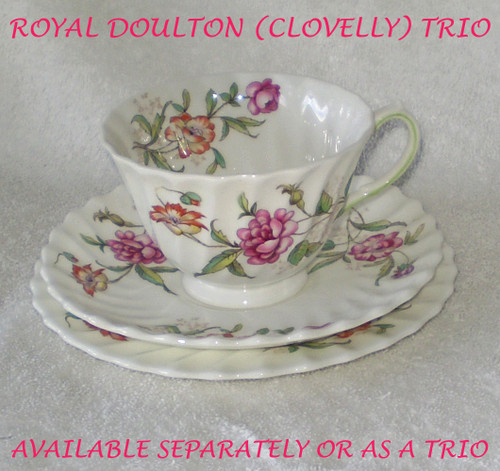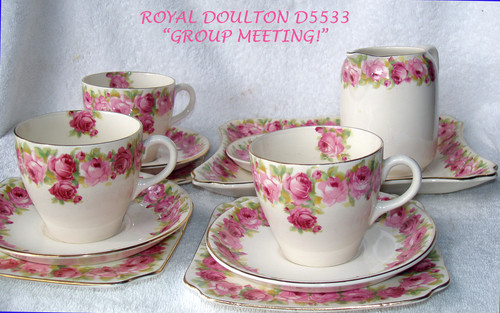BACKGROUND:
This trio teaset dates from 1947 (known because the number 20 is printed to the right of the backstamp and adding 1927, indicates the year of manufacture as 1947, nice straightforward dating system by Doulton but its a shame they didn't always make things so easy!)
At this time, the War was finished with but the British Government "Wartime Concentration scheme" was still in effect. This was a period when there were severe restrictions placed on the operations of all potteries, some works were closed down temporarily or their product focus shifted towards limited domestic supply and also to the all important armed services provisions. The idea was to focus on production of only necessary items and also to free up staff at the pottery works so that they could assist in supporting the war effort and regaining some sort of order after the War had finished.
My wife believes that it is for this reason that pattern is quite "plain" in that there is no Gold gilding at all, based on a plain bright White base colouring with beautiful (but not intricate) hand decorated miniature rose blooms with buds design.
Even with the restrictions placed upon the English potters, Doulton managed to produce what remains to be an attractive (although quite simple) product for the domestic market. Actually this trio is quite "ageless" and could easily be mistaken for contemporary tablewares - clean cut lines with a simple decoration ... stylish, classic Doultonware
DLAT Rating: 9.6/10 (Darling, Look At This!)
If you wish to see the other Royal Doulton that is currently on this website, click HERE
ROYAL DOULTON - Teacup, Saucer & Side Plate
Standard English "one cup" size, not demitasse!
I am offering one complete trio, every piece is available separately (maximum purchasing flexibility) and if the complete trio is purchased, the price is automatically discounted in the checkout.
Translucent (you can easily see the shadow of your fingers when any piece is held to a bright light)
Pattern: Clovelly
Hand decorated*
*Looking very closely at the techniques used for the decoration, it has characteristics of hand painting in that the artist has used a combination of solid brush strokes and "dabs", colours are often overlaid, such as around the foliage. I also noticed that the decoration work is quite sloppy compared to other Doulton ware my wife has presented to me. By this I mean that when viewed extremely closely (magnifying glass), I can see the Black outlines around the various elements e.g a leaf for example. The colouring inside this line misses the mark in places, leaving small dabs of colour OUTSIDE of the Black outline.
To the naked eye, you cannot see these little "human flaws" but take a really close look and they are all over the decorative work.
The design is a simple, "peaceful" groupings of Pink/Magneta miniature rose buds and open blooms with foliage. The teacup has one decoration INSIDE the teacup.
NO pieces have Gold gilding - anywhere.
NO colouring has been added to the rims or edges of any item, but the teacup handle does have some Lime Green decoration on either side.
The base is a fine bone china, bright White (not Cream(ish) in appearance)
This Royal Doulton backstamp is quite straightforward to determine the manufacture year ... the year being 1947 (1927 + 20)
The backstamp is the Royal Doulton logo of the period, printed in an Olive Green with the 20 to the right side of the backstamp on all pieces.
Times were tough back then, very tough in fact. Life was very difficult for many during and after WWII in England - What could be better than a nice "cuppa o' tea" with the Doulton? Remembering and hoping for "normality" to return once again ... don't forget that many households had lost family members to the War ... I couldn't even imagine how it must have been in those days for so many families (I was not "quite born" in 1947 but my Grandparents told me a lot about how life was in those days)
BACKSTAMP DETAILS:
Here are some photographs of the backstamps from these pieces ...
TEACUP Makers mark printed on the base of the teacup
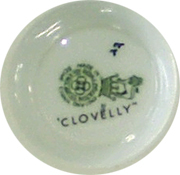
SAUCER Makers mark printed on the base of the saucer
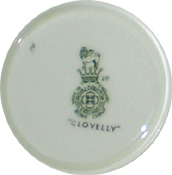
SIDE PLATE Makers mark printed on the base of the side plate
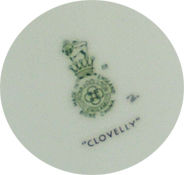
COSMETIC CONDITION:
TEACUP
USED
CLEAN
NO cracks
NO discolouration to the bright White base colouring
NO tannin stains inside the teacup
NO chips to the teacup
NO damage or wear to the hand decorations, including on the handle (most susceptible area)
NO crazing is apparent (Wet or Dry test)
SPECIAL NOTE: I noticed a small Black (or is it Brown?) "dot" on the inside of the teacup. Cleaning (soap & water) made no difference to this "dot" - I then looked very closely at this dot using a magnifying glass and it appears for all the world like a tiny break in the glazing but I am not sure about this. Its a bit tough looking inside a teacup very close up! If you take a gander at the third teacup photograph (looking down inside), you may be able to see this little dot (near the handle, inside and on the side but towards the bottom)
For this reason, the teacup is a lesser asking price than the other two pieces.
SAUCER
USED
CLEAN
NO cracks
NO discolouration to the bright White base colouring
NO chips
NO fleabites
NO damage or wear is apparent to the hand decorations
NO crazing is apparent (Wet and Dry tested)
SIDE PLATE
USED
CLEAN
NO cracks
NO discolouration to the bright White base colouring
NO scratching or knife cuts to the central area of the side plate
NO chips
NO damage or wear to the hand decorations
SPECIAL NOTE: I think we have a couple of fleabites although these are extremely small and I can barely feel them when running my finger across them, they may even be something like a little bubble when they were fired. Normally a fleabite is quite distinct, even when small, but this feels "different" - barely visible to the naked eye in any case.
The one thing that jumps out (for me at least) is that the condition is extremely good for chinaware almost 60 years young ... another thought that comes to mind is that the design looks so "modern" for those times - often it is quite easy to view a 1940's ~ 1950's pattern and date the period it is from quite easily, not this teaset though - if just taking a casual glance I would have taken a guess at these being a 1980's production ... the backstamp and decorative production techniques though show otherwise.

